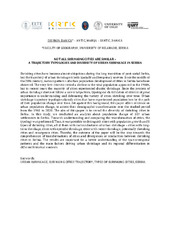Приказ основних података о документу
Not all shrinking cities are similar – a trajectory typologies and diversity of urban shrinkage in Serbia
| dc.creator | Đurkin, Danica | |
| dc.creator | Antić, Marija | |
| dc.creator | Šantić, Danica | |
| dc.date.accessioned | 2023-11-29T16:24:46Z | |
| dc.date.available | 2023-11-29T16:24:46Z | |
| dc.date.issued | 2022 | |
| dc.identifier.isbn | 978-963-489-479-7 | |
| dc.identifier.uri | http://gery.gef.bg.ac.rs/handle/123456789/1651 | |
| dc.description.abstract | Shrinking cities have become almost ubiquitous during the long transition of post-social Serbia, but the trajectory of urban shrinkage is both spatially and temporary uneven. Since the middle of the 20th century, various patterns of urban population development of cities in Serbia have been observed. The very first cities to record a decline in the total population appeared in the 1960s, but in recent years the majority of cities experienced drastic shrinkage. Since the process of urban shrinkage does not follow a universal pattern, typological classification of cities is of great importance in understanding and delineating the variety of cities shrinking over time. Urban shrinkage trajectory typologies classify cities that have experienced population loss by the path of their population change over time. Set against this background, this paper offers evidence on urban population change, to assess their demographic transformation over the studied period from the 1961 to 2020. The aim of this paper is to reveal the diversity of shrinking cities in Serbia. In this study, we conducted an analysis about population change of 167 urban settlements in Serbia. Towards understanding and comparing the transformation of cities, the typology was performed. Thus, it was possible to distinguish cities with population growth and 5 types of shrinking cities, all of them with various features of urban shrinkage – cities with longterm shrinkage, cities with episodic shrinkage, cities with recent shrinkage, potentially shrinking cities and resurgence cities. Thereby, the outcome of the paper will be the step towards the comprehension of transformations of cities and divergences or similarities between shrinking cities in Serbia. The results are important for a better understanding of the spatio‐temporal patterns and the main factors driving urban shrinkage and its regional differentiation in different historical contexts. | sr |
| dc.language.iso | en | sr |
| dc.publisher | Budapest : ELTE Eötvös Loránd University, Institute of Geography and Earth Sciences | sr |
| dc.relation | info:eu-repo/grantAgreement/MESTD/inst-2020/200091/RS// | sr |
| dc.rights | openAccess | sr |
| dc.source | Book of Abstracts of the "Cities After Transition – 9th International Urban Geographies of Post-Communist States Conference (CAT-ference 2022), Budapest | sr |
| dc.subject | urban shrinkage | sr |
| dc.subject | shrinking cities trajectory | sr |
| dc.subject | types of shrinking cities | sr |
| dc.subject | Serbia | sr |
| dc.title | Not all shrinking cities are similar – a trajectory typologies and diversity of urban shrinkage in Serbia | sr |
| dc.type | conferenceObject | sr |
| dc.rights.license | ARR | sr |
| dc.citation.spage | 16 | |
| dc.description.other | Editors: Márton Berki, Zsolt Bottlik, Michael Gentile, Margit Kőszegi, Gábor Nagy, Judit Timár, Gábor Tolnai and Tünde Virág. | sr |
| dc.identifier.fulltext | http://gery.gef.bg.ac.rs/bitstream/id/3518/bitstream_3518.pdf | |
| dc.identifier.rcub | https://hdl.handle.net/21.15107/rcub_gery_1651 | |
| dc.type.version | publishedVersion | sr |


